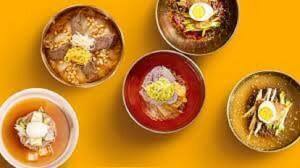“Anywhere else in the world, brothless ramyeon would be the most popular,” says South Korean actor Ryu Soo-Young in the first episode of Netflix’s documentary mini-series K Food Show: A Nation of Broth (Ryu is one of the three hosts; the other two are actor Ham Yon-Ji and artist Huh Young-Man, respectively). “But in Korea, it’s all about the broth. Is it savory, is it spicy? For us ramyeon is not ramyeon without the broth.” The captions also helpfully point out that South Korea has the world’s highest consumption of instant or dried ramyeon. A Nation of Broth is the latest in a slew of Netflix documentary series about Korean food, including Korean Pork Belly Rhapsody (2020) and Korean Cold Noodle Rhapsody (2021). And the show really is warm and inviting and wholesome — you know, like a bowl of warm broth. In the opening episode, the trio travels to South Korea’s Jeju Island, to an old establishment that serves a famously good bowl of seafood ramyeon. Every generous serving would have one local crab, one small-to-medium-sized octopus (served whole, not chopped up), one abalone (Ham’s was still wiggling while the soup was steaming on the table, prompting encouraging nods from the others). The noodles themselves would be al dente to prevent overcooking (a common precaution in restaurant kitchens) and finally, the glorious broth itself, its taste enhanced by using the establishment’s in-house seafood stock, the prep for which we were shown separately. A Nation of Broth is classic ‘slow TV’, meandering along agreeably from one low-key culinary escapade to another. But the three hosts’ enthusiasm, as well as their little asides about the cultural importance of soup/broth in Korea, got me thinking about the importance of food — and aesthetically shot eating sequences — in Korean shows and films, too. [caption id=“attachment_10768731” align=“alignnone” width=“300”]  Korean Cold Noodle Rhapsody[/caption] Mukbang: K-dramas and the art of eating For the past decade or so, a particular genre of Internet video originating from South Korea — whether on TikTok, YouTube or any other platform — has become wildly popular across the world. This is a ‘Mukbang’, wherein the streamer or the person uploading the video eats vast quantities of food while talking the audience through what he’s eating, how it’s prepared and other informational nuggets. A good Mukbang is marked not just by the variety or the quality of the food, but also the enthusiasm and sense of joy conveyed by the streamer. You can see the handprints of this genre of videos in a wide variety of popular K-serials across the last decade. Not to mention, there are shows predating the genre that kind of show us why and how South Korea is the birthplace of the Mukbang itself. The 2016-17 show Weightlifting Fairy Kim Bok-joo featured a great many scenes along these lines, each one marked with the unmistakable giddiness of the Mukbang. In a scene that’s now become a Mukbang classic (and is widely shared on social media), the show’s titular protagonist shows her friends how to properly enjoy a typical Korean-style barbeque. “If you eat at a Korean barbeque joint without any strategy,” she says, “You will be full very quickly. To properly enjoy such a feast you must follow this order.” First come the small and tasty freshly grilled meat bits. Next, there are slightly bigger slices of marinated meat that are grilled or shallow-fried and served right off the pan. At this point, Kim says, one should order the fried rice, which is a must-have at Korean barbeque joints. Finally, as a palate cleanser, you have cold noodles to finish off the feast. Of shows that predate the Mukbang craze, Dae Jung Geum or Jewel in the Palace (2003) is a great example of the way food is linked to memories, madness and romance in K-dramas. Lee Young-ae stars as the titular protagonist, a 15th century orphan cook who rises through the ranks to become the king’s personal physician. She does so by cooking the king’s favorite dishes expertly, foods that the king has emotional connections with. More recently, the Korean show Squid Game became one of Netflix’s biggest international success stories. The Indian-origin actor Anupam Tripathi (who played Ali on the show) was part of the cast for Squid Game, and his success has led many Indian fans to watch his other work too — he often plays characters that highlight the struggles of being an Indian or a Pakistani immigrant in South Korea. In the reality show Home Alone (2013; also called I Live Alone), Tripathi showed off his cooking (and eating) skills in front of some of his colleagues from various Korean shows. Tripathi first makes a cup of chai before making a very simple, standard, homemade chicken curry, with the pieces first being marinated in a basic turmeric-and-salt mix, with a little bit of yogurt for good measure. He then makes parathas, helpfully explaining to his Korean friends what the difference between paratha and naan is. The remarkable thing is that the Korean people watching Tripathi say, “How well he’s eating” almost as much as “how well he’s cooking”. It’s all very wholesome and feel-good and also teaches you about how people from different parts of the world have wildly varying ideas of ‘staple food’. Food as a marker of pride, pathos or redemption In the 2011 South Korean series Kimchi Family, also called Fermentation Family, Song Il-kook plays a gangster who has turned over a new leaf and is now working at a kimchi (a Korean side dish, typically consisting of salted and fermented veggies) restaurant run by two sisters. This is just one of the many K-dramas where the preparation and subsequent consumption of food is linked with a sense of cultural pride as well as the occasional flashback—this flashback could be in the service of pathos or like in Kimchi Family, serve as a redemption arc for the protagonist. From destroying lives and tearing families asunder, Song Il-kook’s character has chosen to nourish people instead — his ‘service’ is measured in terms of the people he serves food every day, literally. As metaphors go, it’s a bit on the nose but the food scenes make it work, to be honest. Another show where these connections are at the heart of the story is Let’s Eat (2013), where four single people are connected by their love of eating well—and eating out. There is a scene from episode five where actress Lee Soo-kyug (whose characters is also named exactly that) schools a restaurant proprietor on the difference between ramen and udon noodles. The three friends then proceed to wolf down servings of Budae Jijigae (a kind of spicy sausage stew that includes ham, sausages, kimchi and noodles) — with extra ham on the side (very important, this, as we learn through the course of the scene). The late Anthony Bourdain, talking about the inextricable connections between food, cultural pride and memory, once wrote: “People are generally proud of their food. A willingness to eat and drink with people without fear and prejudice… they open up to you in ways that somebody visiting who is driven by a story may not get. For a moment, or a second, the pinched expressions of the cynical, world-weary, throat-cutting, miserable bastards we’ve all had to become disappears, when we’re confronted with something as simple as a plate of food.” Something similar is afoot in these Korean TV shows. Food sequences are shot and presented before the audience almost as a metonymic approach to storytelling—with a few quick strokes (or chopstick-twirls) we get to know a lot of important things about the character who’s cooking or eating. We know how they grew up, what they love and hate today, what are the things that are closest to their heart. It’s food as emotional shorthand, basically. It is an efficient storytelling technique, one that’s suited to the needs of K-dramas in particular. In a scene from K Food Show: A Nation of Broth, when the three hosts are at Seogwipo (part of Jeju Island), they are enjoying a delicious bowl of cutlassfish soup. Ryu Soo-Young says, at one point, “The fish travels all the way to Seogwipo because it’s colder here, and that’s why the fish is so delicious”. The older, sardonic Huh Young-Man replies, without missing a beat, “I bet a local from Seogwipo told you that!” This little moment tells you a lot about hyper-local food cultures and the stories that emerge organically out of them. Everybody is proud of their own foods, things that they grew up eating. It’s only natural that in their eyes, even the fish conform to the needs of the culture. A Nation of Broth, like so many other Korean shows (both scripted and otherwise), understands truths like this one, which is why foodies love watching K-dramas. Aditya Mani Jha is a Delhi-based independent writer and journalist, currently working on a book of essays on Indian comics and graphic novels. Read all the Latest News , Trending News , Cricket News , Bollywood News , India News and Entertainment News here. Follow us on Facebook, Twitter and Instagram.
Across the last decade or so, a slew of Korean shows has used aesthetically pleasing food scenes to highlight cultural pride, friendship, love and a host of other emotions effectively.
Advertisement
End of Article


)
)
)
)
)
)
)
)
)



